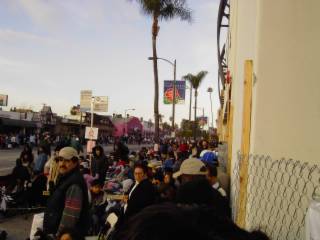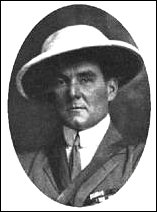
Pasadena's "one-day" residents.

Each year there seems to be agreement on what is the latest technological component to incorporate into the larger floats (not surprising, given that only several firms design and build almost all of the floats you see). This year was CO2 vapors, often paired with waterfalls or the tall JPL astronaut.
The panoramic angle of the television cameras really don't do the floats justice. When compared to the height of buildings or street lights, you get a better perspective. The giant panda float below was typical in size (although, the Honda-sponsored float of a multi-segmented train broke a record for longest float to date).

Your "typical" float.

Most viewers think of the parade a consisting entirely of floats and marching bands. Yet, the origins were much more simple. In the earliest years, circa 116 years ago, The Valley Hunt Club
had their members tie roses and floral arrangements to horse-drawn carriages, which were then paraded along the streets (by the way, the VHC is still located on Orange Grove, where the parade begins). To this day, that tradition continues (and Pasadenans love their traditions, except when it comes to the PAC 10/BIG 10 in the Rose Bowl - goodbye) with at least one or two "old" floats, equestrian units, and sometimes the current leadership of the Valley Hunt Club (whose members created the Tournament of Roses).

The "original" Rose Parade.

A few things most of you won't know: After the first few blocks, the parade doesn't flow as smoothly as on national TV. It is more like a catepillar, a few segments move and get crushed together and others are delayed. So there is more of a "start and stop" flow to most of it. This can be entertaining when marching bands get to take a standing break, or horses - given a moment of peace - elect to relieve themselves on the street (making an extra hazard for marching bands to follow).
When the parade stops, it can often mean that a float has broken down. Some years might have just the one or two floats experiencing "equipment malfunction," while several years ago I counted at least five which couldn't make it the full 5.5 miles. This year there weren't any that I saw (though, there were two more miles to go). In any event, the "real" last entry in the parade is the convoy of large-scale tow trucks at the ready.

The "unoffical" last entries in the parade.

Finally, another shot you won't see in the big-time coverage. The trash, as you can imagine, is impressive. As soon as the parade is over (it takes about two hours), people flee with sleeping bags, tables, chairs and ladders, leaving almost everything else on the ground. Below is the sight the Chamber of Commerce never wants you to see. Yet, by this afternoon, it has been cleaned up. Late last night (actually, this morning) around 3:00 AM I could hear several street sweepers in action, clearing this mess away.

What the cameras never show.

PS - As you can see, it didn't rain on the parade, as was predicted. The last time it did was in 1955 - a year my mother remembers and reminded me about this past weekend. Many (i.e., most) of us still believe that 116 years ago the Valley Hunt Club made a Faustian pact for perfect weather in January 1.
Well, that's it until the news summary tomorrow. I've got a bug and work calls in the morning. If any of you want more pics of the floats, feel free to drop me a line. If not, then this concludes the "Dark Side of the Rose Parade" series for 2005.

No comments:
Post a Comment